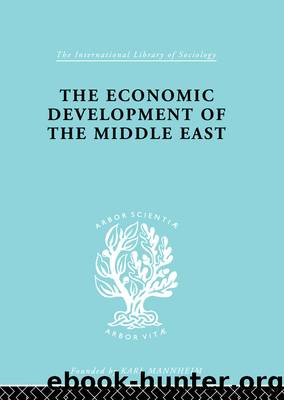The Economic Development of the Middle East by Alfred Bonne

Author:Alfred Bonne [Bonne, Alfred]
Language: eng
Format: epub
Tags: Social Science, Sociology, General
ISBN: 9781136227783
Google: OlXGTASFMqoC
Publisher: Routledge
Published: 2013-07-04T04:11:58+00:00
* Average of 1924â8.
In Syria and the Lebanon the situation in this respect appears somewhat more favourable, because the industrial agility of the population of that country has for decades been calling industrial enterprises into being. As a consequence, local workers there show a more favourable disposition towards intensified industrialization than those in Egypt and in the certainly far less developed Iraq and Transjordan. But in view of the very limited scope of these enterprises in the Syrian States, no definite prognosis can be offered as to the capacity of local production for competition with foreign produce, if and when the former assumes larger dimensions.
Turkey is characterized by a clear-cut policy of developing local industry at the expense of imports on a scale scarcely known elsewhere. Being the principal director of production and industry, the state has no immediate problems of foreign competition to fear.
(c) THE AVAILABILITY OF WORKERS AND TECHNICAL STAFF
The general tendency towards increase of population, coupled with the shifting of workers from rural to urban occupations, will doubtless go far to satisfy the rising demand for industrial labour. According to our estimate included in the table on page 88, very substantial additions to the number of industrial earners are to be expected as a result of these trends, although the percentages themselves will show only moderate rises. Take Egypt again as example. Instead of 588,000 industrial earners in 1934â5 there would be 1,053,000 in 1962. A considerable proportion of this increase will be engaged in the production of industrial goods for the peasant population as well as for rural housing, as may be seen from the following estimate:
Let it be assumed that, according to the estimates on page 78, an additional amount of £80·6 million will be spent directly on manufactured goods in 1962, a demand will then arise for 269,000 new industrial workers, on the basis of £300 as the average value of gross output per worker. A further demand for secondary produce can, moreover, be expected to result from the building industry. According to our tables on pp. 76â7 (first line) the potential investment in housing, rural and urban, amounts to approximately £10·9 million per annum, after deducting the share of industrial goods in this total, which has been estimated by us at £5·24 million. The cost of paid labour in building has not been computed here, but may be estimated at 30 per cent. of total costs (excluding industrial goods used in construction), i.e. at £3·3 million. This amount may, on a conservative estimate, provide work for 55,000 people on an annual wages basis of £60 per earner. Altogether we shall thus have 324,000 earners in secondary occupations, building included, so that only 141,000 earners would be available to cater for the higher needs of the urban population in âsecondaryâ products. These figures, however, provide for a reserve, as the rising degree of efficiency in industry is bound to decrease the number of workers required to produce the same unit of goods. Another reserve
Download
This site does not store any files on its server. We only index and link to content provided by other sites. Please contact the content providers to delete copyright contents if any and email us, we'll remove relevant links or contents immediately.
International Integration of the Brazilian Economy by Elias C. Grivoyannis(74911)
The Radium Girls by Kate Moore(11621)
Turbulence by E. J. Noyes(7701)
Nudge - Improving Decisions about Health, Wealth, and Happiness by Thaler Sunstein(7242)
The Black Swan by Nassim Nicholas Taleb(6767)
Rich Dad Poor Dad by Robert T. Kiyosaki(6176)
Pioneering Portfolio Management by David F. Swensen(6079)
Man-made Catastrophes and Risk Information Concealment by Dmitry Chernov & Didier Sornette(5649)
Zero to One by Peter Thiel(5490)
Secrecy World by Jake Bernstein(4388)
Millionaire: The Philanderer, Gambler, and Duelist Who Invented Modern Finance by Janet Gleeson(4096)
The Age of Surveillance Capitalism by Shoshana Zuboff(3987)
Skin in the Game by Nassim Nicholas Taleb(3966)
The Money Culture by Michael Lewis(3847)
Bullshit Jobs by David Graeber(3831)
Skin in the Game: Hidden Asymmetries in Daily Life by Nassim Nicholas Taleb(3723)
The Dhandho Investor by Mohnish Pabrai(3560)
The Wisdom of Finance by Mihir Desai(3524)
Blockchain Basics by Daniel Drescher(3329)
